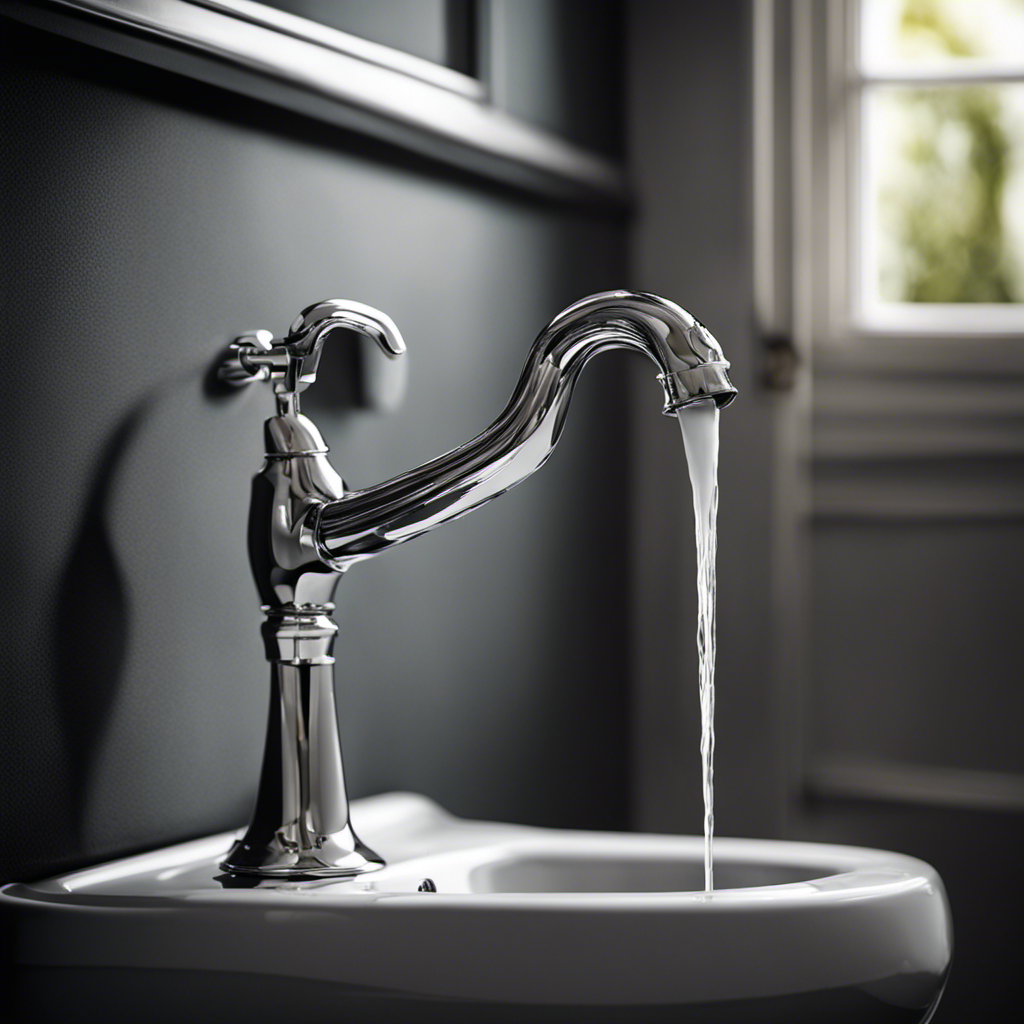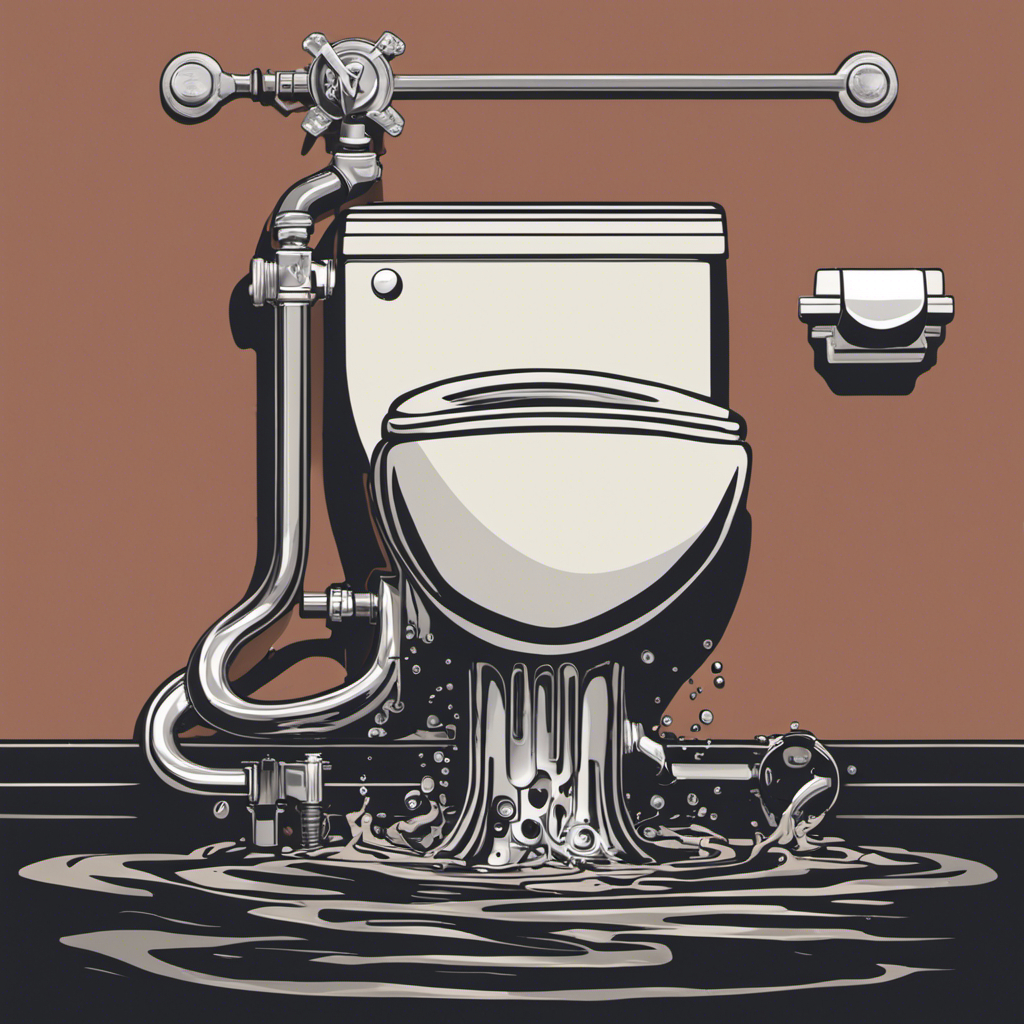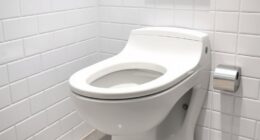Did you know that a leaking toilet can waste up to 200 gallons of water per day? That’s enough to fill a bathtub six times!
In this article, I’ll guide you through the step-by-step process of turning off your toilet’s water supply. By understanding the shut-off valve, locating it, and shutting off the fill valve, you’ll be able to prevent any further water wastage and tackle any issues that may arise.
Let’s get started on conserving water and saving money!
Key Takeaways
- The shut-off valve is a crucial component of a toilet’s plumbing system that can prevent water wastage and troubleshoot water flow issues.
- The shut-off valve can be located near the base of the toilet and is usually identified as a small lever or wheel.
- There are two main types of shut-off valves: angle stop valve and straight stop valve, with the angle stop valve typically located behind the toilet bowl and the straight stop valve found in the basement or crawl space.
- To turn off the water supply, turn the handle of the angle stop valve clockwise until it stops, or turn the handle of the straight stop valve clockwise until it is fully closed.
Understanding the Toilet Shut-off Valve
To turn off the water to your toilet, locate the shut-off valve on the wall behind the toilet. The shut-off valve is a crucial component of your toilet’s plumbing system. Understanding valve maintenance is essential for troubleshooting toilet water flow issues.
The shut-off valve controls the water supply to your toilet, allowing you to stop the flow of water when needed. Over time, these valves can develop leaks or become stiff, affecting their functionality. Regular maintenance, such as lubricating the valve stem and checking for any leaks, can help ensure smooth operation.
If you notice reduced water flow or constant running of the toilet, it may indicate a problem with the shut-off valve. By understanding how the shut-off valve works and how to maintain it, you can effectively troubleshoot any water flow issues.
Now, let’s move on to locating the shut-off valve.
Locating the Shut-off Valve
You can easily find the shut-off valve by checking near the base of the toilet. It is usually a small lever or wheel that controls the flow of water to the toilet. Identifying shut off valves is crucial for troubleshooting issues with your toilet. If you are experiencing a leak, clog, or any other problem, the first step is to turn off the water supply. This prevents further damage and allows you to work on fixing the issue. Here is a handy table to help you understand the different types of shut-off valves commonly found in toilets:
| Valve Type | Description | Location |
|---|---|---|
| Compression | Traditional design | Near base of toilet |
| Ball Valve | Easy to turn | Near base of toilet |
| Gate Valve | Longer handle | Near base of toilet |
Shutting off the Water Supply
By familiarizing yourself with the different shut-off valve types, you can easily identify and control the water flow to your toilet.
When it comes to shutting off the toilet water supply, there are two main types of shut-off valves you may encounter: the angle stop valve and the straight stop valve.
The angle stop valve is typically located behind the toilet bowl, near the floor. To shut off the water using this valve, simply turn the handle clockwise until it stops.
On the other hand, the straight stop valve is usually found in the basement or crawl space, near the water main. To shut off the water using this valve, turn the handle clockwise until it is fully closed.
Once you have successfully shut off the toilet water supply, you can move on to turning off the toilet’s fill valve.
Turning off the Toilet’s Fill Valve
When it comes to turning off the toilet’s fill valve, there are a few key points to keep in mind.
First, it’s important to locate and identify the valve, which is typically located on the wall behind the toilet.
Once you’ve located the valve, shutting off the water supply is as simple as turning the valve clockwise until it is fully closed.
To complete this task, you will need a few tools, including an adjustable wrench or pliers to grip and turn the valve.
Valve Location and Identification
The valve for turning off the toilet water can usually be found near the wall behind the toilet. It is essential to know the location and identification of this valve for proper valve maintenance and troubleshooting leaks.
The valve is typically a small, round knob or lever connected to a water supply line. It is often made of metal or plastic and may be labeled with ‘shut-off’ or ‘stop.’ To locate the valve, start by visually inspecting the area behind the toilet. Look for a pipe coming out of the wall that connects to the toilet tank. Follow this pipe until you find the valve.
If you cannot locate it visually, try feeling along the wall for a small knob or lever. Once you have identified the valve, you can use it to turn off the water supply to the toilet for maintenance or to stop leaks.
Shutting off Water Supply
You can usually find the valve for shutting off the toilet water near the wall behind the toilet. It is important to know how to turn off the water supply in case of a toilet water leak, as this can prevent water damage in your home.
Here are three steps to follow when shutting off the water supply to your toilet:
-
Locate the shut-off valve: Look for a small knob or lever connected to a pipe near the base of the toilet. It is usually on the left side or behind the toilet.
-
Turn off the valve: To shut off the water supply, turn the valve clockwise until it is fully closed. This will stop the flow of water to the toilet.
-
Test the shut-off: After turning off the valve, flush the toilet to ensure that the water flow has stopped completely. This will confirm that the shut-off valve is working properly.
Tools Needed for Task
It’s important to have the necessary tools for the task at hand. When it comes to shutting off the water supply to a toilet, there are a few essential tools that you will need.
First and foremost, you will need a pair of adjustable pliers. These will come in handy when loosening and tightening the water supply valve.
Additionally, a bucket or a towel is useful to have on hand to catch any water that may spill during the process. A flashlight can also be helpful, especially if the shut-off valve is located in a dark area.
Lastly, having a backup shut-off valve, such as a water meter key or a shut-off wrench, can be beneficial in case the main shut-off valve is not functioning properly.
Draining the Toilet Bowl
To drain the toilet bowl, simply hold down the flush lever until the water stops flowing. This is the most basic and common method used for draining a toilet bowl. However, there are other draining techniques that can be employed if this method does not work.
Here are some troubleshooting tips to help you effectively drain your toilet bowl:
-
Plunger Method: Use a plunger to create suction and dislodge any blockage in the toilet drain. Plunge vigorously and repeat as necessary until the water drains.
-
Snake Method: Use a plumber’s snake to manually remove any clogs or debris from the toilet drain. Insert the snake into the drain and rotate it clockwise to dislodge and remove the blockage.
-
Gravity Method: If all else fails, you can try using gravity to drain the toilet bowl. Turn off the water supply to the toilet, then use a bucket or a cup to scoop out the water from the bowl until it is empty.
Remember to always exercise caution when attempting any draining technique and if the problem persists, it may be best to consult a professional plumber.
Dealing With a Stuck or Broken Shut-Off Valve
If the shut-off valve is stuck or broken, it’s important to consult a professional plumber. Dealing with a stuck shut-off valve can be a frustrating experience, but attempting to repair it yourself can lead to further damage or leaks. A skilled plumber will have the necessary expertise and tools to safely fix the issue.
When it comes to repairing a broken shut-off valve, it’s crucial to address the problem promptly to avoid water damage. A broken valve can result in a continuous flow of water, leading to flooding and costly repairs. By contacting a professional plumber, you can ensure that the shut-off valve is repaired correctly and efficiently.
Once the valve is fixed, you can proceed to the next step of turning the water back on.
Turning the Water Back On
When it comes to restoring normal water flow after dealing with a stuck or broken shut-off valve, there are two key points to consider: water valve location and the process of restoring the water flow.
First, it is crucial to locate the main water valve, which is typically found near the water meter or where the main water supply enters the building.
Once located, turning the valve counterclockwise will restore the water flow. However, it is important to proceed with caution to avoid any potential water damage or further complications.
Water Valve Location
The water valve’s location can sometimes be difficult to find. However, it is crucial to know its whereabouts for water valve maintenance and preventing water leaks. Here are three steps to help you locate the water valve:
-
Check near the toilet: The water valve is usually located near the base of the toilet. Look for a small lever or wheel attached to a pipe.
-
Look in the utility room: If you can’t find the valve near the toilet, check in the utility room or basement. It is often located near the main water supply line.
-
Follow the pipes: Trace the pipes from the toilet to their source. The water valve is typically located along the path of these pipes.
Once you have located the water valve, you can proceed to the next step of restoring normal water flow.
Restoring Normal Water Flow
To restore normal water flow, you should first locate the water valve. If you are experiencing low water pressure or other water flow issues, there are several troubleshooting steps you can take.
First, check if the main water valve is fully open. It is usually located near the water meter or where the main water line enters your home. Ensure that it is turned on completely.
Next, inspect the water pressure regulator, which is typically found near the main water valve. Make sure it is functioning properly and adjust it if necessary.
If these steps do not resolve the issue, you may need to check for any clogs or blockages in the plumbing system. This can be done by inspecting the water supply lines and faucets for any obstructions.
Additionally, consider checking the pressure relief valve and the water heater for any problems that may be affecting the water flow.
Frequently Asked Questions
How Do I Know if My Shut-Off Valve Is Stuck or Broken?
If my shut-off valve is stuck or broken, I can’t turn off the toilet water. Signs of a broken shut-off valve include leaks or difficulty turning the valve. To fix a stuck valve, I could try lubricating it or replacing it if necessary.
Can I Use Any Tool to Turn off the Shut-Off Valve?
When it comes to shutting off the water supply to a toilet, it’s important to use the proper tools. Using alternative tools can damage the shut-off valve, so it’s best to stick to the recommended methods for proper shut-off valve maintenance.
What Should I Do if the Shut-Off Valve Is in a Hard-To-Reach Location?
If the shut-off valve is difficult to reach, there are alternative solutions you can try. For example, you can use a toilet valve shut-off tool or call a professional plumber for assistance.
Is It Necessary to Drain the Toilet Bowl Before Turning off the Water Supply?
Should I turn off the toilet water supply before leaving for vacation and how to properly drain the toilet bowl before doing so? Yes, it is necessary to turn off the water supply and flush the toilet multiple times to drain the bowl completely.
How Can I Prevent the Shut-Off Valve From Getting Stuck or Broken in the Future?
To prevent future issues with the shut-off valve, I recommend taking preventive measures like regular maintenance and lubrication. Troubleshooting tips include checking for any leaks, ensuring proper alignment, and avoiding excessive force when operating the valve.
Conclusion
In conclusion, turning off the toilet water may seem daunting, but with the right knowledge, it can be done easily.
Remember to always locate the shut-off valve, shut off the water supply, and turn off the toilet’s fill valve before draining the toilet bowl.
It is important to note that 1 in 5 households experience a toilet-related water leak. These leaks can lead to significant water waste and costly repairs.
By knowing how to turn off the toilet water, you can prevent such leaks and contribute to water conservation efforts.










